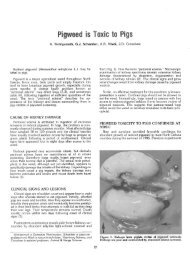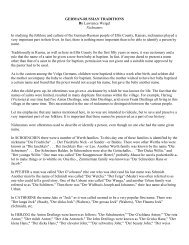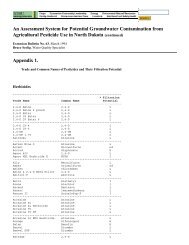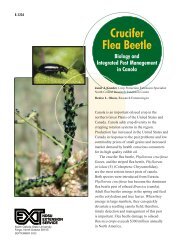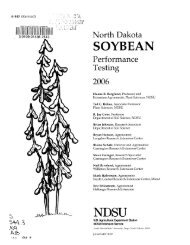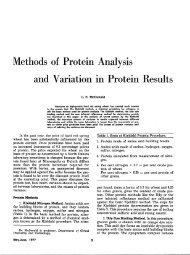germans from russia in fort collins, 1900-2000 - Libraries
germans from russia in fort collins, 1900-2000 - Libraries
germans from russia in fort collins, 1900-2000 - Libraries
You also want an ePaper? Increase the reach of your titles
YUMPU automatically turns print PDFs into web optimized ePapers that Google loves.
WORK RENDERS LIFE SWEET: GERMANS FROM RUSSIA IN FORT COLLINS<br />
While three-day wedd<strong>in</strong>g festivities have<br />
long s<strong>in</strong>ce vanished <strong>from</strong> the German-<br />
Russian community, some traditions rema<strong>in</strong>:<br />
guests still p<strong>in</strong> money to the bride’s gown for<br />
the pleasure of a dance; the sound of the hammered<br />
dulcimer still leads Dutch Hops (lively<br />
polkas); and, of course, homemade noodles,<br />
butterball soup, and rye bread rema<strong>in</strong> the<br />
cul<strong>in</strong>ary highlight of any German-Russian<br />
celebration.<br />
German-Russian Labor:<br />
The Cycle of Work<br />
Built upon the cycle of faith, Sykes <strong>in</strong><br />
Second Hoe<strong>in</strong>g also develops the cycle of<br />
labor. The four parts of her book correspond<br />
to the four components of the beet cycle:<br />
plant<strong>in</strong>g, th<strong>in</strong>n<strong>in</strong>g, hoe<strong>in</strong>g, and harvest<strong>in</strong>g.<br />
She uses this cycle of labor as way to develop<br />
the story and as a metaphor for the evolution<br />
of the family and the maturation of the<br />
protagonist, Hannah Schreissmiller. S<strong>in</strong>ce<br />
their arrival on the steppes, Germans <strong>from</strong><br />
Russia have developed an <strong>in</strong>domitable work<br />
ethic. Moreover, fieldwork was a family<br />
affair, spar<strong>in</strong>g neither women nor children.<br />
As the patriarch, or Hausvater, of a<br />
German-Russian family sought a contract<br />
with a farmer, he became part of a far larger<br />
and complex system of economics that governed<br />
the sugar beet <strong>in</strong>dustry. Long protected<br />
by government-imposed tariffs, sugar prices<br />
still varied greatly <strong>from</strong> season to season. The<br />
problem for Great Western was that the company<br />
had to guarantee a m<strong>in</strong>imum price for<br />
sugar beets almost a year before the sugar<br />
<strong>from</strong> those beets would hit the market.<br />
Generally the profit marg<strong>in</strong> on a pound of<br />
sugar was only one to one-and-a-half cents.<br />
Thus, the sugar companies had to negotiate<br />
contracts with farmers that took <strong>in</strong>to consideration<br />
future market conditions – especially<br />
supply – while cont<strong>in</strong>u<strong>in</strong>g to make it profitable<br />
for those farmers to grow beets. Into<br />
this complicated system came the contract<br />
laborers, who agreed to tend a specified<br />
acreage of beets. Even as late as 1924, laborers<br />
were paid only $21 to $24 per acre each<br />
year. In order to survive, an <strong>in</strong>dividual laborer<br />
had to agree to tend far more acres that he<br />
could possibly do himself. The answer?<br />
Employ his entire family <strong>in</strong> tend<strong>in</strong>g the beets<br />
while keep<strong>in</strong>g costs such as rent and food as<br />
low as possible. The result was a system that<br />
paid the lowest wages to those who worked<br />
the hardest. Moreover, farmers could not pay<br />
the laborers until they themselves received a<br />
check <strong>from</strong> the sugar company. To assist their<br />
contract laborers <strong>in</strong> surviv<strong>in</strong>g lean times,<br />
farm owners often established l<strong>in</strong>es of credit<br />
for German-Russian families at local merchants.<br />
72<br />
Beet campaigns began <strong>in</strong> late March or<br />
April with sow<strong>in</strong>g and th<strong>in</strong>n<strong>in</strong>g and cont<strong>in</strong>ued<br />
to November with harvest<strong>in</strong>g. Because<br />
“s<strong>in</strong>gle germ” beet seeds were not developed<br />
until the 1950s, farmers actually planted a<br />
wad of seeds that, <strong>in</strong> a few weeks, produced a<br />
patch of twisted beet plants. Laborers crawled<br />
along the rows of beets, us<strong>in</strong>g a hoe to<br />
“block” the beets so that plants were twelve<br />
to fourteen <strong>in</strong>ches apart. Then the blocks<br />
were th<strong>in</strong>ned by hand, remov<strong>in</strong>g the weakest<br />
plants and reta<strong>in</strong><strong>in</strong>g the healthiest. Because<br />
this work required so much nimble handwork<br />
and little strenuous lift<strong>in</strong>g, the sugar companies,<br />
farmers, and the patriarchs of the<br />
German-Russian families considered th<strong>in</strong>n<strong>in</strong>g<br />
ideal work for children. After block<strong>in</strong>g<br />
and th<strong>in</strong>n<strong>in</strong>g, which could take up to a month<br />
and a half depend<strong>in</strong>g on the acreage, the families<br />
then turned to hoe<strong>in</strong>g. This <strong>in</strong>volved pil<strong>in</strong>g<br />
soil around the beet plants while remov<strong>in</strong>g<br />
weeds. Accomplished <strong>in</strong> two stages – first<br />
and second hoe<strong>in</strong>gs – the second stage could<br />
span <strong>from</strong> mid summer to the harvest <strong>in</strong><br />
SWCA Environmental Consultants Page 21



